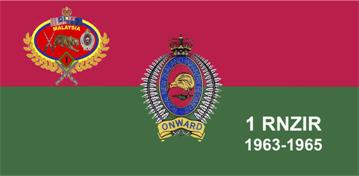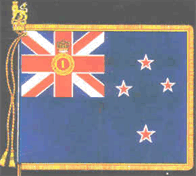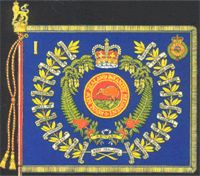Home Page
1 RNZIR Unit History
South Vietnam
Battle Honours
Page sponsored by www.nzmilitarymedals.com
www.nzmilitarymedals.com
Medals mounting,
replica medals
& accessories.
1 RNZIR Unit History
South Vietnam
Battle Honours
Page sponsored by www.nzmilitarymedals.com

www.nzmilitarymedals.com
Medals mounting,
replica medals
& accessories.
Regimental Battle Honours
The major contents on this page are:- Regimental Colours
- Battle Honours
- Carrying the Colours
- Saluting the Colours
- Formation of 1st Battalion Royal New Zealand Infantry Regiment
- First Battalion Royal New Zealand Infantry Regiment Colours
- 1 RNZIR - Battalion Former Colours
- First Battalion Royal New Zealand Infantry Regiment Battle Honours
Regimental Colours
The colours of military units are memorials to great deeds of a regiment, and the symbol of its spirit as expressed in those deeds. When colours were carried on active service they were the rallying point of a regiment and often at the scene of its last stand, acts of heroic self-sacrifice were often performed in their defence.This association of colours with heroic deeds has caused them to be regarded with veneration. Before colours are taken into use, they are consecrated, as battle flags have been associated with religion since ancient times. In the Legions of ancient Rome, the Standards were worshiped. Pope Alexander II is said to have consecrated the banner of William the Conqueror at the Battle of Hastings in 1066.
In 1751, a British Army regulation prescribed that there would be only two colours in each regiment: The First, or King's Colour and the Second, or Regimental colour. The term Regimental Colour was officially recognised in 1844.
Why two colours?
King George VI is quoted as saying of the Kings colour "...it is the Kings colour, and therefore the symbol of the loyalty which you owe to your country", thus being the paramount of the two. That colour representing the regiment ... "enshrines the history embodies the traditions and represents the ideals... ", of the regiment.
A battle honour is a military tradition practiced in the Commonwealth countries of the United Kingdom, Australia, Canada, and New Zealand and is an official acknowledgement rewarded to military units for their achievements in specific wars or operations of a military campaign.
Source: 1
Battle Honours
A battle honour is granted through the Royal Prerogative of the monarch of Great Britain and the Commonwealth. It is comparable to a unit citation in other national traditions.A battle honour may be granted to infantry/cavalry regiments or battalions, but with the exception of Royal Navy ships and Royal Air Force squadrons, they are rarely granted to sub-units such as companies, platoons and sections in the army.
Battle honours are usually presented in the form of a name of a country, a region or a city where the regiment's distinguished act took place, together with the year when it occurred. Supporting corps/branches such as medical, service, ordnance, artillery, engineer, or transport do not receive battle honours.
The honours for the First and Second World War were restricted in that only a certain number of honours could be selected for emblazonment - such as to appear on colours or drums. This was due to the large number of Battle Honours awarded.
It is often the case that battle honours not carried on the colours, limited by space and design, are emblazoned on the drum major's baldric.
Source: 2
Carrying of the Colours
In the Middle Ages for example, the Regiment's bravest subaltern carried the colours in battle. Since the falling of the colours in action represented defeat of the forces, troops would often attack them. Hence arose a need for escorts, originally pikemen.In this modern era, although colours no longer appear on the battlefield, they remain objects of respect, and many of the traditions started during the Middle Ages still exist today. Particularly that of the youngest subaltern of the regiment carrying of the colours when they are formally paraded, surrounded by the most experienced fighting men of the regiment, known as the 'Escort to the Colours'.
Saluting the Colours
Regiments take pride in their battle honours, and the winning of further battle honours, as these are seen to enhance a unit's reputation.It remains a tradition that whenever military personnel meet a colour or guidon, it must be saluted. This is not only because it is an object which represents the authority of the Crown, but also because the colours contain a regiment's battle honours, and thus represent the regiment's history and its dead.
Source: 2
Formation of 1st Battalion Royal New Zealand Infantry Regiment - 1964

1 RNZIR flag embossed with monogram and the 'Original's' period in Malaysia
The red over green colours are the same as used by the 22 Battalion. The Unit adopted them in early 1940 when the battalion was formed, with the colours being those of the Onslow Rugby Club in Wellington.
The 1st Battalion Royal New Zealand Infantry Regiment was formed on May 1, 1964. The Battalion was deployed in Malaysia at that time, based in Terendak Military Camp as a unit of the 28th Commonwealth Brigade. The Brigade was a part of the 17th Gurkha Division whose command was based in Hong Kong.
The origin of the Battalion was the result of a decision to abolish the ten separate Infantry Regiments which made up the Royal New Zealand Infantry Corps and to form a single Infantry Regiment with numbered Battalions. At that time there were two active regular Infantry Battalions, the 1st and 2nd Battalions of the New Zealand Regiment.
On the formation of the Royal New Zealand Infantry Regiment there two dresswear changes for all personnel. A green beret replaced the former headwear and a new cap badge replaced that of the New Zealand Regiment.
The 1st Battalion Royal New Zealand Infantry Regiment [1 RNZIR] was born from amalgamation of these two Battalions.
Inaugural Parade - 1st Battalion Royal New Zealand Infantry Regiment
Due to operational commitments on the Malaysian - Thailand border the ceremonial parade to mark the formation of the new Battalion and granting of the title "Royal" was delayed until 5 Aug 1964. On 17 August 1964, the Battalion was committed to active service on the Malay Peninsula against invading Indonesian regular forces.Unit Red Diamond Insignia - 1st Battalion Royal New Zealand Infantry Regiment
Of significance was retention of the 2nd Battalion New Zealand Infantry Regiment unit insignia, being a cloth RED DIAMOND worn on the upper left sleeve on the dress wear of battalion members.The RED DIAMOND was instituted for 2 Battalion as recognition of its antecedent being 22nd Battalion 2nd New Zealand Expeditonary Force [2NZEF]. The 22nd Battalion was the longest serving of the New Zealand infantry battalions that made up the 2NZEF from 1939 to 1947. The Battalion was disbanded in Japan on 7th August 1947 to become the 2nd Battalion of the NZ Army.
Source: 22 Battalion - Paul Froggatt
First Battalion Royal New Zealand Infantry Regiment Colours
The "new" Queen's and Regimental Colours of 1st Battalion The Royal New Zealand Infantry Regiment were presented for the first time at a ceremony in Fitzherbert Park, Palmerston North, on 12-13 April 1997. |
 |
| 1 RNZIR - Queen's Colours | 1 RNZIR - Regimental Colours |
1 RNZIR - Battalion Former Colours
The old, or former, set of Colours were presented to the Battalion by Lieutenant General Sir Leonard Thornton KCB, CBC, at Dieppe Barracks 25 September 1971. The Battalion continued to carry these Colours in both South East Asia and on return to New ZealandSource: 3
First Battalion Royal New Zealand Infantry Regiment Battle Honours
Battle honours are listed in choronological order, either in a single list, or in multiple even numbers of columns, reading left to right, and top to bottom. On drums, the honours are listed on scrolls, usually with the cap badge central, and other unit devices present, such as a representation of a unit distinction or motto.Determining Battle Honours for New Colours
Although the regular force army 1st and 2nd Battalions of The New Zealand Regiment possessed Colours, these were rendered void on 1 May 1964, on the creation of the Royal New Zealand Infantry Regiment whilst the 2nd Battalion was stationed at Terendak Military Camp, Malaysia.New Colours were now required and one hundred and five Battle Honours previously awarded to the ten separate infantry regiments were to be inherited by the new single regiment.
It was decided that each battalion could emblazon twenty-two Battle Honours on its Regimental Colour. It was also determined that the battalions of the Royal New Zealand Infantry Regiment could emblazon twenty-two Battle Honours of its own choosing.
The Battle Honours were to be made up of:
- NEW ZEALAND
- SOUTH AFRICA
- Ten selected from the First World War
- Ten selected from the Second World War
Battle Honours Antecedants for New Colours
Brigadier T.C. Campbell CBE, DSO, MC, ED, the Honorary Colonel of the 1st Battalion, declared that whilst the 1st Battalion had not directly inherited any Battle Honours, its antecedents were the Regular Infantry drawn from the whole of New Zealand and he felt that the 1st Battalion Royal New Zealand Infantry Regiment would be proud to emblazon twenty-two Battle Honours including the Honour NEW ZEALAND.After discussion with the then Commanding Officer of the battalion, Lieutenant Colonel R.M. Gurr MBE, Brigadier T.C. Campbell confirmed to Army Headquarters that the 1st Battalion Royal New Zealand Infantry Regiment wished the following Battle Honours to be emblazoned on it's Regimental Colours:
Pre World War One:
|
World War One:
|
World War Two:
|
Approval of Battle Honours
The New Zealand Army Board approved the allocation of Battle Honours in 1966, and requested the Inspector of Regimental Colours in the United Kingdom to prepare final drawings of the Queen's and Regimental Colours for the battalions of the Royal New Zealand Infantry Regiment.The twenty-two Battle Honours were to be emblazoned in accordance with current practice and custom, and in the upper right hand comer the New Zealand Regiment Crest. In the past where two regiments were amalgamated, it has been Army Board policy to authorise the crests of the old regiments to be borne on the Regimental Colour of the new regiment as honorary distinction badges.
Accordingly, the crest of the New Zealand Regiment is borne on the Regimental Colour of 1st Battalion Royal New Zealand Infantry Regiment.
Regimental Motto
The Regimental Motto is ONWARD and this also is inscribed on the Regimental Colour. The motto, ONWARD, was embodied in New Zealand's first Coat of Arms granted in 1911 following the proclamation of Dominion status.
The Motto was then used on the General Service Badge of the British section of the First New Zealand Expeditionary Force. Their badge was two fem leaves enclosing the letters NZ above a scroll inscribed 'ONWARD' and the whole surmounted by a Tudor crown. The remainder of the force wore the same badge with EXPEDITIONARY FORCE instead of 'ONWARD' inscribed on the scroll.
 The Motto 'ONWARD' was by the Second New Zealand Expeditionary Force and all members wore the badge inscribed so. The Motto was adopted on the Royal New Zealand Infantry Regiment badge in 1964. By it's very meaning the Motto 'ONWARD' symbolises the spirit of the New Zealand Infantry.
The Motto 'ONWARD' was by the Second New Zealand Expeditionary Force and all members wore the badge inscribed so. The Motto was adopted on the Royal New Zealand Infantry Regiment badge in 1964. By it's very meaning the Motto 'ONWARD' symbolises the spirit of the New Zealand Infantry.
 The Motto 'ONWARD' was by the Second New Zealand Expeditionary Force and all members wore the badge inscribed so. The Motto was adopted on the Royal New Zealand Infantry Regiment badge in 1964. By it's very meaning the Motto 'ONWARD' symbolises the spirit of the New Zealand Infantry.
The Motto 'ONWARD' was by the Second New Zealand Expeditionary Force and all members wore the badge inscribed so. The Motto was adopted on the Royal New Zealand Infantry Regiment badge in 1964. By it's very meaning the Motto 'ONWARD' symbolises the spirit of the New Zealand Infantry.Royal Assent for Battle Honour for South Vietnam 1967 - 1970
In 1991 Her Majesty Queen Elizabeth II gave her Royal Assent to the approval of the Battle Honour for South Vietnam 1967 - 1970. This Battle Honour is now emblazoned on the current Regimental Colour.Source: 4
Sources:
1] Royal Canadian Army Service Corps
2] Wikipedia
3] Digger History;
4] Souvenir booklet Presentation of Colours to the First Battalion Royal New Zealand Infantry Regiment; 12-13 April 1997
1] Royal Canadian Army Service Corps
2] Wikipedia
3] Digger History;
4] Souvenir booklet Presentation of Colours to the First Battalion Royal New Zealand Infantry Regiment; 12-13 April 1997
Updated 29 July 2018. Webmaster, Victor R Johnson. Contact Webmaster, Webmaster



